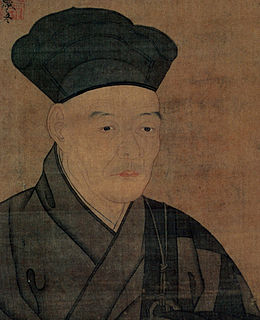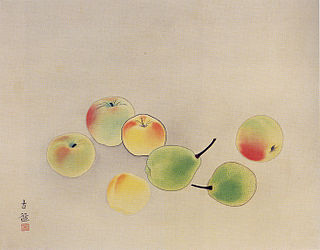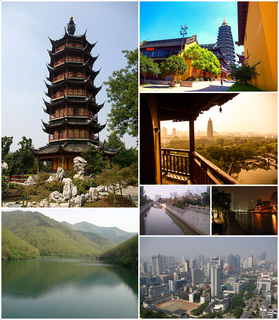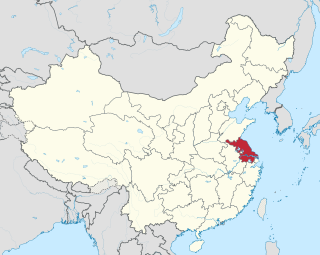
Chinese art is visual art that, whether ancient or modern, originated in or is practiced in China or by Chinese artists. The Chinese art in the Republic of China (Taiwan) and that of overseas Chinese can also be considered part of Chinese art where it is based in or draws on Chinese heritage and Chinese culture. Early "stone age art" dates back to 10,000 BC, mostly consisting of simple pottery and sculptures. After this early period Chinese art, like Chinese history, is typically classified by the succession of ruling dynasties of Chinese emperors, most of which lasted several hundred years.

Ink wash painting, or sumi-e (墨絵), is a type of East Asian brush painting that uses black ink – as used in East Asian calligraphy – in different concentrations. Emerging in Tang dynasty China (618–907), it, and associated stylistic features, overturned earlier, more realistic techniques. These associated features include a preference for shades of black over variations in colour, and an emphasis on brushwork and the perceived "spirit" or "essence" of a subject over direct imitation. It flourished in the Song dynasty (960–1279), as well as Japan after it was introduced by Zen Buddhist monks in the 14th century.

Jiangyin is a county-level city on the southern bank of the Yangtze River, and is administered by Wuxi, Jiangsu province. Jiangyin is one of the most important transport hubs on the Yangtze River, it is also one of the most developed counties in China.

The Kanō school is one of the most famous schools of Japanese painting. The Kanō school of painting was the dominant style of painting from the late 15th century until the Meiji period which began in 1868, by which time the school had divided into many different branches. The Kanō family itself produced a string of major artists over several generations, to which large numbers of unrelated artists trained in workshops of the school can be added. Some artists married into the family and changed their names, and others were adopted. According to the historian of Japanese art Robert Treat Paine, "another family which in direct blood line produced so many men of genius ... would be hard to find".

Sesshū Tōyō was the most prominent Japanese master of ink and wash painting from the middle Muromachi period. He was born into the samurai Oda family (小田家), then brought up and educated to become a Rinzai Zen Buddhist priest. However, early in life he displayed a talent for visual arts, and eventually became one of the greatest Japanese artists of his time, widely revered throughout Japan and China.

Landscape painting, also known as landscape art, is the depiction of landscapes in art – natural scenery such as mountains, valleys, trees, rivers, and forests, especially where the main subject is a wide view – with its elements arranged into a coherent composition. In other works, landscape backgrounds for figures can still form an important part of the work. Sky is almost always included in the view, and weather is often an element of the composition. Detailed landscapes as a distinct subject are not found in all artistic traditions, and develop when there is already a sophisticated tradition of representing other subjects.

Xia Gui, courtesy name Yuyu (禹玉), was a Chinese landscape painter of the Song dynasty. Very little is known about his life, and only a few of his works survive, but he is generally considered one of China's greatest artists. He continued the tradition of Li Tang, further simplifying the earlier Song style to achieve a more immediate, striking effect. Together with Ma Yuan, he founded the so-called Ma-Xia (馬夏) school, one of the most important of the period.

Yamato-e (大和絵) is a style of Japanese painting inspired by Tang dynasty paintings and fully developed by the late Heian period. It is considered the classical Japanese style. From the Muromachi period, the term Yamato-e has been used to distinguish work from contemporary Chinese-style paintings, which were inspired by Chinese Song and Yuan-era ink wash paintings.

Yun Shouping (惲壽平), also known as Nantian (南田), was a major artist of the early Chinese Qing dynasty. He was regarded as one of the "Six Masters" of the Qing period, together with the Four Wangs and Wú Lì.

Japanese painting is one of the oldest and most highly refined of the Japanese visual arts, encompassing a wide variety of genres and styles. As with the history of Japanese arts in general, the long history of Japanese painting exhibits synthesis and competition between native Japanese aesthetics and the adaptation of imported ideas, mainly from Chinese painting which was especially influential at a number of points; significant Western influence only comes from the later 16th century onwards, beginning at the same time as Japanese art was influencing that of the West.
Muqi Fachang was a Chinese Chan Buddhist monk and painter who lived in the 13th century, around the end of the Southern Song dynasty (1127–1279). Today, he is considered to be one of the greatest Chan painters in history. His ink paintings, such as the Daitokuji triptych and Six Persimmons are regarded as essential Chan paintings. Muqi's style of painting has also profoundly impacted painters from later periods to follow, especially monk painters in Japan.

Nihonga are Japanese paintings from about 1900 onwards that have been made in accordance with traditional Japanese artistic conventions, techniques and materials. While based on traditions over a thousand years old, the term was coined in the Meiji period of Imperial Japan, to distinguish such works from Western-style paintings, or Yōga (洋画).
Kaihō Yūshō; real name: Kaiho Shōeki, "brush name": Yusho, was a Japanese painter of the Azuchi–Momoyama period. He was born in Ōmi province, the fifth son of Kaihō Tsunachika, who was a vassal of Azai Nagamasa.

Kanō Tan'yū was one of the foremost Japanese painters of the Kanō school. His original given name was Morinobu; he was the eldest son of Kanō Takanobu and grandson of Kanō Eitoku. Many of the most famous and widely known Kanō works today are by Tan'yū.
Bird-and-flower painting is a kind of Chinese painting named after its subject matter. Normally, most bird-and-flower paintings belong to the scholar-artist style of Chinese painting.
Guan Daosheng was a Chinese poet and painter who was active during the early Yuan Dynasty. She is credited with being "the most famous female painter in Chinese history...remembered not only as a talented woman, but also as a prominent figure in the history of bamboo painting."

Wang Yuanqi was a Chinese painter of the Qing dynasty.

Cizhou ware or Tz'u-chou ware is a term for a wide range of Chinese ceramics from between the late Tang dynasty and the early Ming dynasty, but especially associated with the Northern Song to Yuan period in the 11–14th century. It has been increasingly realized that a very large number of sites in northern China produced these wares, and their decoration is very variable, but most characteristically uses black and white, in a variety of techniques. For this reason Cizhou-type is often preferred as a general term. All are stoneware in Western terms, and "high-fired" or porcelain in Chinese terms. They were less high-status than other types such as celadons and Jun ware, and are regarded as "popular", though many are finely and carefully decorated.

The Changzhou Museum is a comprehensive museum in the city of Changzhou, in southern Jiangsu province of China. Established in 1958, it exhibits a large collection of artifacts, and has a research department. There are eight sections and more than 20,000 cultural relics. High-quality relics include original green porcelain of the Spring and Autumn period and Warring States period, lacquerware and porcelains in Song and Yuan dynasties and paintings and calligraphy in Qing and Ming dynasties and so on. Changzhou museum was awarded the title of "Patriotic education base of Jiangsu province" and "Excellent museum of Jiangsu province". Over its first fifty years, the museum moved three times. The new building has been located to the west of People's Square since December 2006, and was opened to the public on April 28, 2007.
























